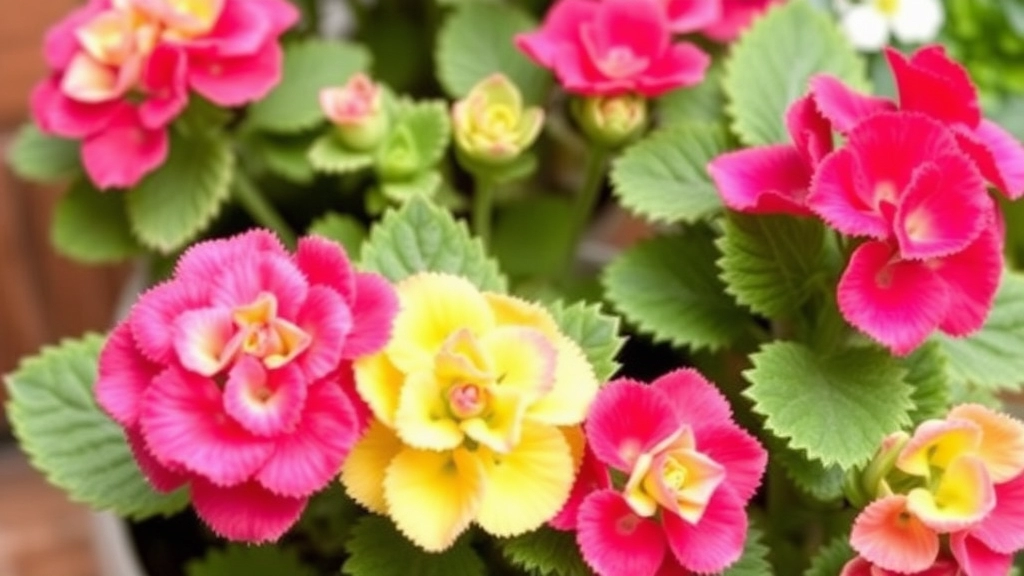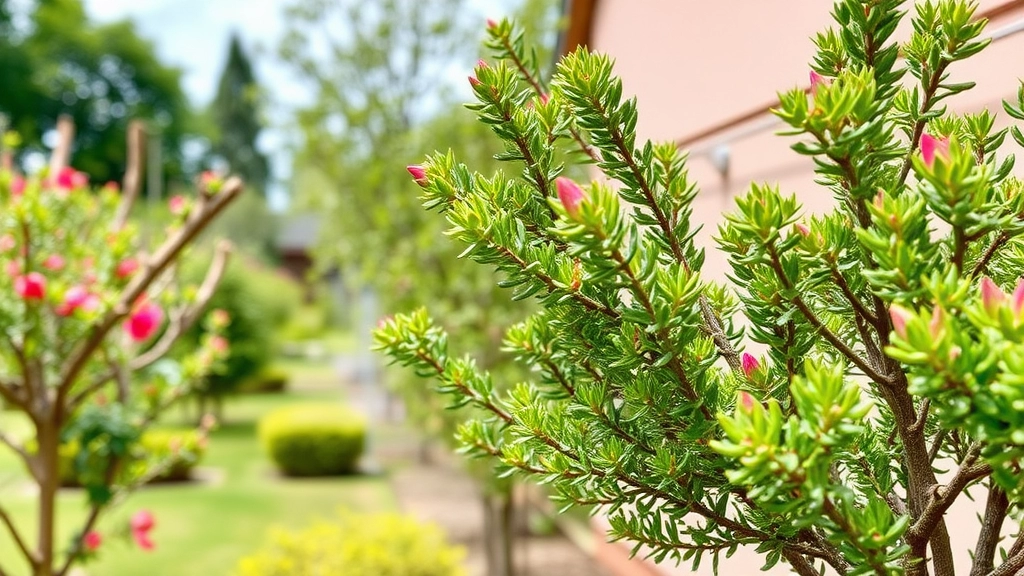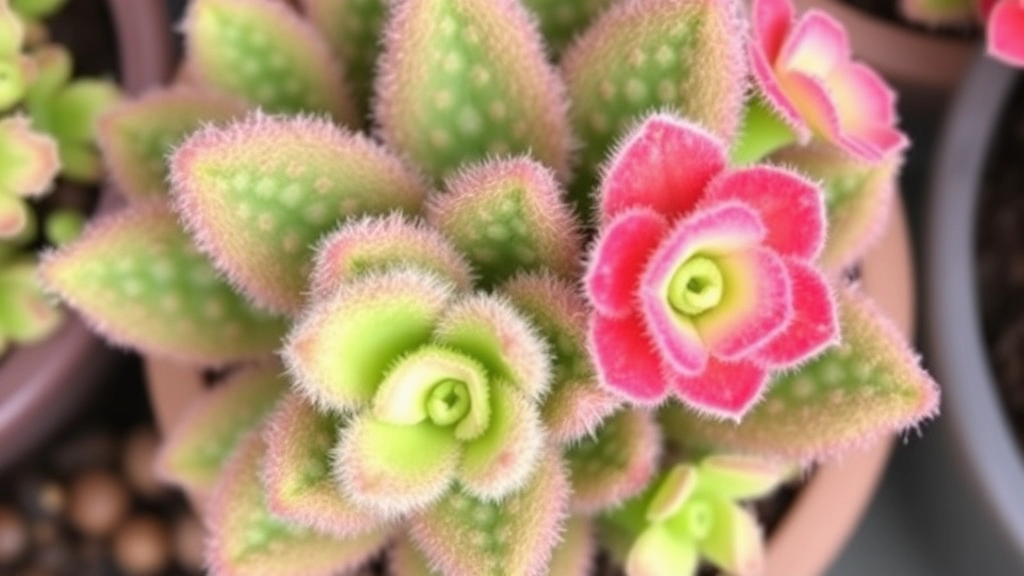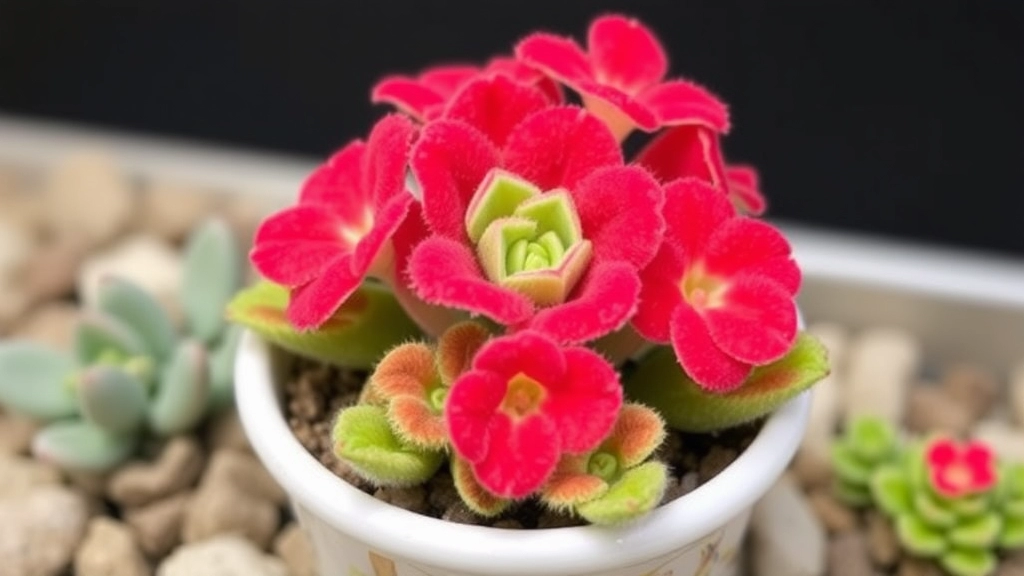Mastering Fuzzy Kalanchoe Care
If you’re looking to master Fuzzy Kalanchoe care, you’ve come to the right place. I know how satisfying it is to see those fuzzy leaves thrive. In this guide, I’ll share practical tips for watering, sunlight, and soil needs to keep your Fuzzy Kalanchoe healthy and happy.
Watering
First, let’s talk about watering. Overwatering is a big no-no. Make sure the soil is dry before giving it a drink.
Sunlight
Next, sunlight is crucial. Place your plant in a spot where it gets plenty of indirect light.
Soil
Lastly, use well-draining soil to prevent root rot. Follow these steps, and your Fuzzy Kalanchoe will flourish.
Choosing the Right Soil for Fuzzy Kalanchoe
When it comes to growing Fuzzy Kalanchoe, selecting the right soil is crucial for its health and vitality. Many plant enthusiasts often wonder what type of soil will provide the best environment for their beloved succulent.
Soil Composition
Fuzzy Kalanchoe thrives in well-draining soil. Here are some key components to consider:
- Cactus Mix: This is a popular choice as it offers excellent drainage.
- Perlite or Pumice: Adding these materials improves aeration and drainage.
- Organic Matter: A small amount of compost can provide essential nutrients without retaining too much moisture.
pH Levels
Aim for a slightly acidic to neutral pH level, ideally between 6.0 and 7.0. This range supports healthy growth and nutrient absorption.
Container Choice
Ensure the pot has drainage holes. This prevents water from accumulating, which is vital for preventing root rot. For more detailed information on growing this type of succulent, you can check out our guide on Kalanchoe Tomentosa care. Additionally, if you’re interested in exploring other fuzzy varieties, our top fuzzy Kalanchoe types guide can be very helpful.
Optimal Light Conditions

Have you ever wondered why your Fuzzy Kalanchoe isn’t thriving?
The secret often lies in the light conditions.
Getting this right can make all the difference between a happy plant and a sad one.
Understanding Light Needs
Fuzzy Kalanchoe loves bright light.
Here’s how to ensure it gets just the right amount:
- Direct Sunlight: Place it in a spot where it can soak up direct sunlight for at least 4-6 hours a day. A south-facing window is usually perfect.
- Filtered Light: If direct sunlight is too harsh, filtered light works too. Think sheer curtains or a spot that gets dappled sunlight.
- Avoid Low Light: Keep it away from dark corners. Low light can lead to leggy growth and a lack of those lovely fuzzy leaves.
Signs of Proper Light
Wondering if you’ve nailed it?
Look out for these signs:
- Vibrant Growth: Healthy, lush leaves that are full and fuzzy.
- Blooms: If your plant flowers, it’s a good sign it’s happy with its light situation.
What If It’s Too Much?
Sometimes, less is more.
If you notice:
- Burnt Leaves: Brown tips or crispy edges mean it’s getting too much sun.
- Wilting: A plant that wilts despite adequate watering might be stressed from too much light.
Adjusting Light Levels
If you need to make changes, do it gradually.
Sudden shifts can shock your plant.
Watering Guidelines for Fuzzy Kalanchoe
When it comes to caring for your Fuzzy Kalanchoe, watering can often be a source of confusion. How do you know when to water? How much is enough?
Understanding Water Requirements
Fuzzy Kalanchoe, like many succulents, thrives in drier conditions. Overwatering is one of the most common mistakes that can lead to root rot. Here are some essential tips to keep your plant happy:
- Check the Soil: Before watering, always check the soil moisture. Insert your finger about an inch deep. If it feels dry, it’s time to water.
- Watering Frequency: During the growing season (spring and summer), water every two to three weeks. In the dormant season (autumn and winter), reduce this to once a month.
- Watering Method: When you do water, ensure you do so thoroughly. Water until it drains from the bottom of the pot, ensuring the roots receive adequate moisture.
- Use Well-Draining Soil: Pair your watering routine with well-draining soil to prevent water from sitting around the roots.
Signs of Overwatering and Underwatering
Knowing the signs of overwatering and underwatering can help you adjust your care routine:
Temperature and Humidity Requirements for Fuzzy Kalanchoe

When caring for your Fuzzy Kalanchoe, understanding its temperature and humidity needs is crucial.
What Temperature Does Fuzzy Kalanchoe Prefer?
- Ideal Range: Fuzzy Kalanchoe thrives in temperatures between 18°C to 24°C (65°F to 75°F).
- Avoid Extremes: Keep it away from drafts and sudden temperature changes. They dislike temperatures below 10°C (50°F).
Humidity Levels
- Moderate Humidity: This plant prefers moderate humidity levels. Aim for around 40% to 60%.
- Dry Air: If your home is particularly dry, consider using a humidifier or placing a shallow tray of water near the plant.
Tips for Maintaining Optimal Conditions
- Location: Place your Fuzzy Kalanchoe in a warm room, avoiding cold windows or doors.
- Monitor: Regularly check the temperature and humidity, especially during seasonal changes.
Fertilization Tips for Fuzzy Kalanchoe
As we delve into the essential care for your Fuzzy Kalanchoe, fertilization plays a pivotal role in promoting healthy growth and vibrant foliage.
Understanding Fertilization Needs
Fuzzy Kalanchoe, like many succulents, thrives on minimal fertilization. However, providing the right nutrients can significantly enhance its growth.
- Frequency: Fertilize your Fuzzy Kalanchoe every 4-6 weeks during the growing season (spring and summer).
- Type of Fertilizer: Use a balanced, water-soluble fertilizer diluted to half strength. A fertiliser with an N-P-K ratio of 10-10-10 or similar is ideal.
- Organic Options: If you prefer organic methods, consider using compost tea or a diluted fish emulsion, which can provide essential nutrients without the risk of over-fertilization.
Signs of Over-Fertilization
Be attentive to your plant. Signs of over-fertilization include:
- Yellowing leaves
- Leaf drop
- Stunted growth
If you notice these symptoms, flush the soil with water to remove excess fertilizer.
Seasonal Adjustments
Adjust your fertilization routine as seasons change. In autumn and winter, reduce or eliminate fertilization, as the plant enters dormancy.
For more detailed guidance on caring for Kalanchoe plants, check out our Complete Care Guide for Kalanchoe Panda Plant and learn about Kalanchoe Tomentosa Watering Best Practices and Tips.
VI. Pruning and Maintenance

So, you’ve got your Fuzzy Kalanchoe thriving, but how do you keep it looking its best?
Pruning and maintenance are key to ensuring your plant stays healthy and vibrant.
Why Prune?
You might wonder, “Do I really need to prune my plant?”
Absolutely! Pruning helps:
- Encourage bushier growth
- Remove any dead or damaged leaves
- Shape the plant for a more aesthetic look
When to Prune
Timing is everything!
The best time to prune your Fuzzy Kalanchoe is during the spring or early summer.
This is when the plant is actively growing, making it easier for it to bounce back.
How to Prune
Here’s a simple guide to get you started:
- Gather your tools: You’ll need clean, sharp scissors or pruning shears.
- Identify the areas to prune: Look for any dead or yellowing leaves, as well as any leggy growth.
- Make clean cuts: Cut just above a leaf node to encourage new growth.
- Don’t overdo it: Aim to remove no more than a third of the plant at a time.
Maintenance Tips
Keeping your Fuzzy Kalanchoe in tip-top shape doesn’t stop at pruning.
Here are some quick maintenance tips:
- Dust off the leaves: Wipe the leaves with a damp cloth to keep them clean and help with photosynthesis.
- Check for pests: Regularly inspect your plant for any signs of pests like mealybugs or aphids.
- Rotate your plant: Give it a gentle turn every few weeks to ensure even growth.
Common Pests and Diseases
As we dive deeper into caring for your Fuzzy Kalanchoe, it’s essential to address the potential pests and diseases that can affect its health.
Propagation Methods for Fuzzy Kalanchoe

So, you’ve got a thriving Fuzzy Kalanchoe, and now you’re wondering how to create more of these beauties? Propagation is a fantastic way to expand your collection without breaking the bank. Plus, it’s super rewarding to see those little cuttings grow into full-fledged plants.
Methods of Propagation
- Leaf Cuttings
– Take a healthy leaf from your Fuzzy Kalanchoe.
– Let it dry for a few hours to form a callus.
– Place it in well-draining soil, keeping it slightly moist.
– In a few weeks, you should see roots forming! - Stem Cuttings
– Snip off a stem with a few leaves attached.
– Again, let it dry for a few hours.
– Stick it in soil, water sparingly, and watch it grow. - Offsets
– If your plant produces offsets (little baby plants), gently separate them from the main plant.
– Plant them in their own pots with suitable soil.
Tips for Successful Propagation
- Timing is Key: Spring or early summer is the best time to propagate.
- Humidity Matters: Keep the cuttings in a humid environment to encourage root growth.
- Patience is a Virtue: It might take a few weeks for roots to develop, so don’t rush it.
I remember the first time I propagated my Kalanchoe. I was so nervous, but when those little roots started to peek out, it felt like a mini victory!
Seasonal Care Adjustments for Fuzzy Kalanchoe
As we transition through the seasons, adapting your care routine for your Fuzzy Kalanchoe is essential for its health and vibrancy.
FAQs on Fuzzy Kalanchoe Care
What are the optimal light conditions for Fuzzy Kalanchoe?
Fuzzy Kalanchoe thrives in bright light. It requires direct sunlight for at least 4-6 hours daily, ideally in a south-facing window. If direct sunlight is too harsh, filtered light through sheer curtains or dappled sunlight works well. Avoid placing it in low-light areas as it can lead to leggy growth and less vibrant leaves.
How can I tell if my Fuzzy Kalanchoe is getting the right amount of light?
Signs of proper light include healthy, lush, and full fuzzy leaves. Additionally, if your plant blooms, it’s a positive indicator that it is happy with its light conditions.
What should I do if my Fuzzy Kalanchoe is getting too much light?
If you notice burnt leaves with brown tips or crispy edges, or if the plant wilts despite adequate watering, it might be getting too much sun. Gradually adjust the light levels to avoid shocking the plant.
What temperature range is ideal for Fuzzy Kalanchoe?
Fuzzy Kalanchoe prefers temperatures between 18°C to 24°C (65°F to 75°F). Avoid exposing it to temperatures below 10°C (50°F) and keep it away from drafts and sudden temperature changes.
What humidity levels does Fuzzy Kalanchoe need?
This plant prefers moderate humidity levels, around 40% to 60%. If your home is particularly dry, consider using a humidifier or placing a shallow tray of water near the plant.
When and why should I prune my Fuzzy Kalanchoe?
Pruning is best done during the spring or early summer when the plant is actively growing. Pruning helps encourage bushier growth, removes dead or damaged leaves, and shapes the plant for a more aesthetic look.
How do I prune my Fuzzy Kalanchoe?
To prune, gather clean, sharp scissors or pruning shears. Identify and remove dead or yellowing leaves and any leggy growth. Make clean cuts just above a leaf node to encourage new growth, but avoid removing more than a third of the plant at a time.
What are the methods of propagating Fuzzy Kalanchoe?
Fuzzy Kalanchoe can be propagated through leaf cuttings, stem cuttings, and offsets. For leaf cuttings, take a healthy leaf, let it dry to form a callus, and then place it in well-draining soil. For stem cuttings, snip off a stem with leaves, let it dry, and then plant it in soil. Offsets can be gently separated from the main plant and planted in their own pots.
What tips can help ensure successful propagation?
Propagation is best done in spring or early summer. Keep the cuttings in a humid environment to encourage root growth, and be patient as it may take a few weeks for roots to develop.
How can I maintain my Fuzzy Kalanchoe?
Regular maintenance includes dusting off the leaves with a damp cloth, checking for pests like mealybugs or aphids, and rotating the plant every few weeks to ensure even growth.
References
-
Fuzzy Kalanchoe Light Requirements – Gardening Know How
-
How to Grow and Care for Kalanchoe – The Spruce
-
Kalanchoe Tomentosa – House Plants Expert
